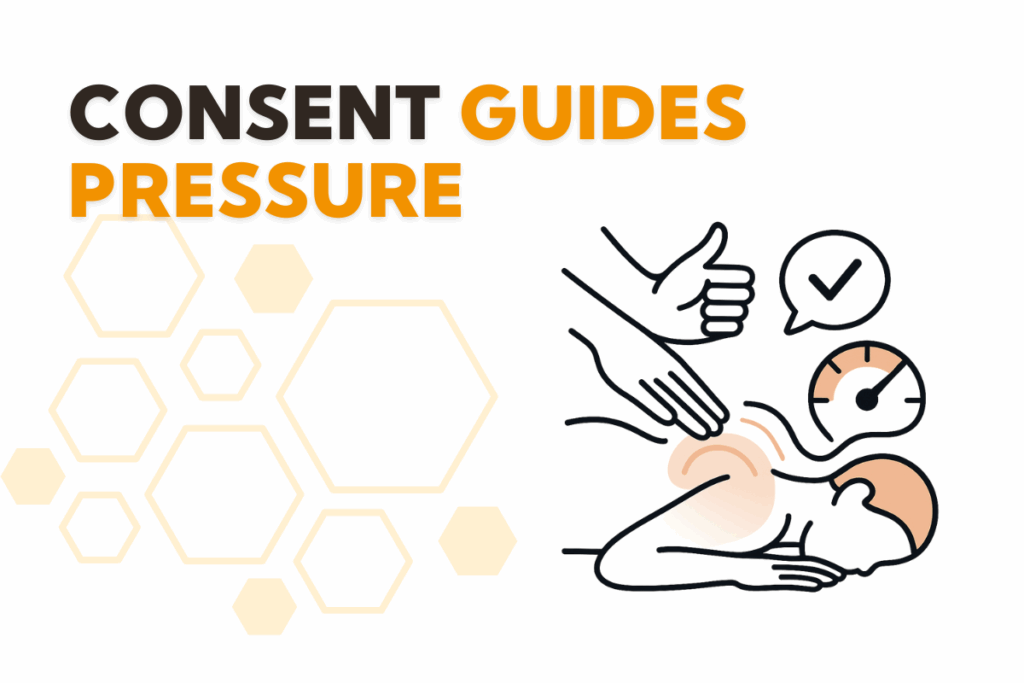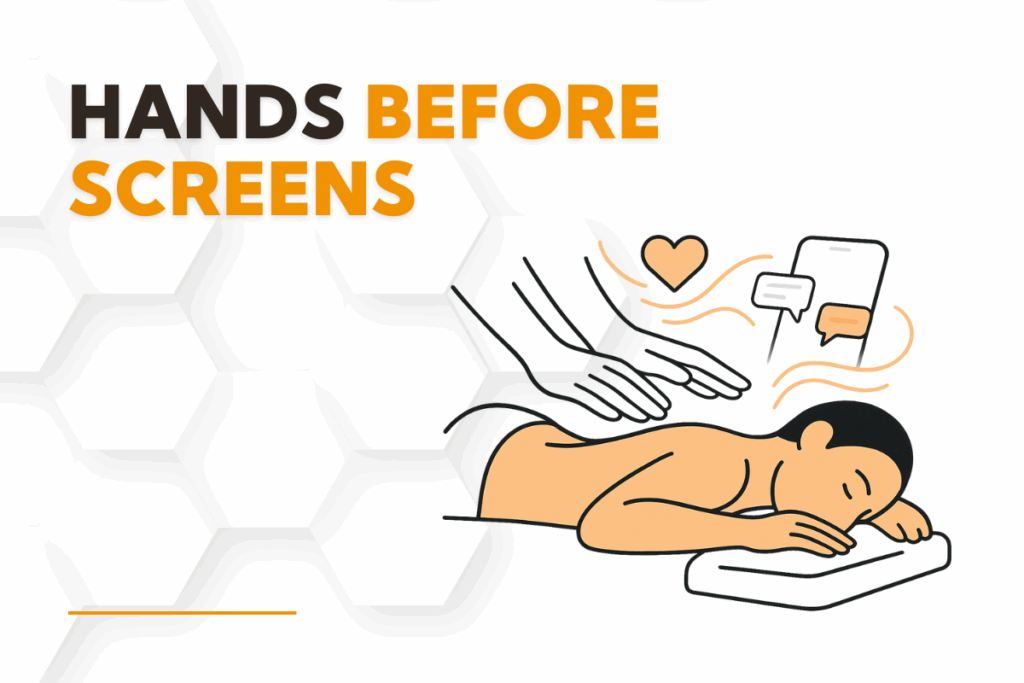Intuition in Massage Therapy is the quiet skill that makes full schedules feel effective, not thin, and it is the clinical edge your clients notice when trust and results improve.
Why Intuition in Massage Therapy Matters Now
When the day looks perfect but care feels flat
Your bookings hum, documentation is tidy, and reminders fire on time. In the room, breath is guarded and pressure requests climb even when tissues say slow. Intuition in Massage Therapy explains this gap. It centers the first minutes, it keeps consent alive, and it gives therapists permission to adjust safely without losing pace.
The operational squeeze owners feel
Hiring, training, and new tools raise cognitive load. Intuition in Massage Therapy helps your team navigate that load by turning body reads into clear decisions that protect outcomes and pride in the work.
What Intuition in Massage Therapy Really Is
Pattern recognition you can trust
Intuition in Massage Therapy is not guessing. It is fast recognition shaped by hands-on hours, client stories, and outcomes you have seen. It works best with real feedback and shared language, so small signals become safe actions.
When your read should lead
The intake is clean and a client booked deep pressure. On contact, you feel bracing and see shallow breath. Intuition in Massage Therapy says pause, re-check consent, adjust the plan, and document the change in two lines. The result is safer care and clearer next steps.
Guardrails That Protect Intuition Without Slowing the Day
Protect the first five minutes
Make minute one screen free and face to face. Ask what needs to feel better by tonight, where it shows up, and what a good session would look like. Capture one client-quoted goal in your plan. Intuition in Massage Therapy grows fastest when the client’s words guide technique and pacing.
Use a simple body-read scale
Green means proceed, Yellow means lighten and clarify, Red means pause and reassess. Say the color out loud, then record the reason. Intuition in Massage Therapy becomes a team habit when everyone shares the same language.
Create visible pause authority
Post a one paragraph policy that empowers therapists to slow or modify when safety or goals require it. Include the expected sentence to the client, how consent is re-checked, and the two line note format. Intuition in Massage Therapy stays credible when owners back these choices.
Keep notes human and useful
Replace generic phrases with functional goals in the client’s words. “Turn my head while driving without a pull” teaches the next therapist what success means today.

Scripts That Invite Truth, Not Compliance
Language that keeps agency with the client
“I am noticing your breath is tight. I would like to begin lighter and build together if that feels right.”
“If anything feels like too much, say so and I will adjust.”
“Success today would be what, exactly.”
Consent as a living process
Record what changed, why it changed, and the client’s agreement. Two clear lines keep consent active and protect continuity.
Training Ladder: Grow Intuition as a Team Skill
Early career
Pair shadowing with live narration. Debrief for two minutes, and practice the exact Yellow and Red sentences. Short pressure calibration drills turn words into feel.
Mid career
Lead two case huddles a month. Share one “system said X, body said Y” moment, the action you took, and the outcome. Intuition in Massage Therapy becomes teachable when examples are specific.
Leads and educators
Build a clinic glossary of felt signs and matching actions. Add a three item alliance check at the end of sessions to keep feedback loops alive.
Documentation that teaches
Anchor entries with sensory detail and the client quote. The next therapist can read the room faster and continue progress without guesswork.
Operations That Let Presence Breathe
Schedule design that respects complexity
Give new grads five protected minutes for charting and offer optional intake extensions for complex cases. Small buffers prevent downstream delays and preserve calm starts.
Room setup that signals safety
Chair at eye level, consent reminder card on the tray, gentle light, one slow breath cue before contact. These cues help the nervous system settle so hands can guide the plan.
Use technology to clear space for people
Automate nonclinical tasks so humans can focus on intake, consent, and reassessment. Keep a human in the loop for any suggestion the system makes and reserve clinical decisions for the therapist who is present. Strengthen decisions with clinic reporting analytics and save team energy with automate admin workflows.
For a broader view on why ongoing relationships improve results, see this review on continuity of care and mortality in BMJ Open.

Measurement: Prove That Protecting Intuition Pays Off
Leading indicators you can shift quickly
Track an alliance mini score at checkout, the share of notes that include a client quoted goal, documented plan adjustments per 100 sessions, and the rate of on time restarts after a Yellow call. Intuition in Massage Therapy should show up here within weeks.
Lagging indicators that confirm value
Watch rebooking within 14 days, progress on function goals, fewer safety related modifications, and higher client reported trust. These trends confirm that Intuition in Massage Therapy is driving stable outcomes.
A simple 12 week dashboard plan
Weeks one to four, set baselines. Weeks five to eight, implement the first five minutes ritual and pause authority. Weeks nine to twelve, add case huddles and light note reviews. Keep what moves outcomes and adjust buffers as needed.
Stories From the Room
When the chart said deep tissue
The plan started strong, but first contact showed guarding and a shallow breath. The therapist called Yellow, explained the read, reset expectations, and began slower. Neck rotation improved, and the client rebooked in seven days. The craft worked because Intuition in Massage Therapy led the plan.
The new grad who learned to name what they feel
Mentorship plus micro scripts helped a new therapist notice bracing in the first seconds. They invited collaboration, adjusted pressure early, and charted the change. Confidence rose, notes improved, and rebooking stabilized. This is Intuition in Massage Therapy growing through feedback and language.
Where to Start Today
Five small steps that build momentum
Write and post the pause policy so everyone sees it. Move the laptop away for the first five minutes and ask for one client quoted goal. Add the Green Yellow Red line to your SOAP template. Hold one ten minute case huddle this week. Tell the team what changed because Intuition in Massage Therapy had room to work.
FAQs
Yes, when paired with experience and clear feedback. Intuition in Massage Therapy is trained recognition, not a guess. Use it with active consent and brief notes so decisions stay transparent and safe.
Early adjustments can feel slower. Over a plan of care, sessions become more targeted, explanations get shorter, and rebooking stabilizes. Intuition in Massage Therapy often saves time across the week.
Keep it to two lines. Note what you observed, the change you made, and that the client agreed. For example, Yellow due to guarding on light contact, shifted to slower techniques with client agreement. Intuition in Massage Therapy remains visible in the record.
Start with two quick checks. Record the share of notes that include a client quoted goal and the count of documented plan adjustments. Add rebooking within 14 days next. These connect presence to performance and show progress fast.


